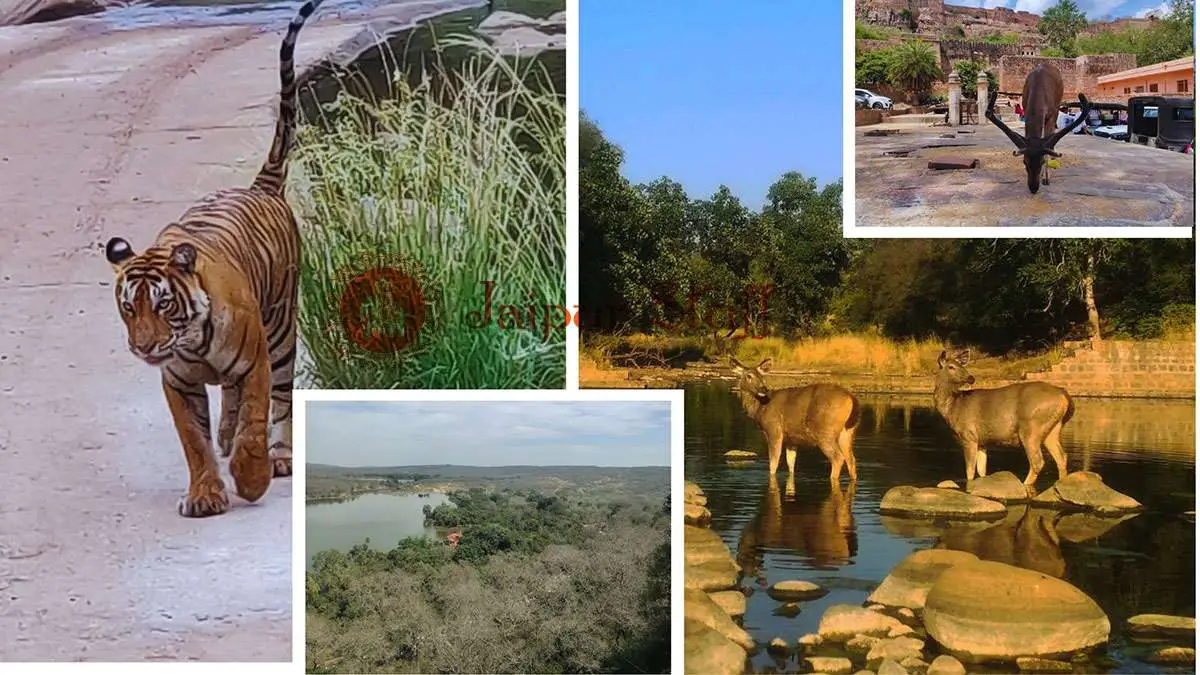Ranthambore Wildlife Guide: Discovering the Breathtaking Flora and Fauna of Ranthambore

Welcome to our comprehensive Ranthambore Wildlife Guide, where we delve into the enchanting world of Ranthambore National Park’s diverse and awe-inspiring wildlife. Situated in Rajasthan, India, Ranthambore is renowned for its rich biodiversity, captivating visitors with its remarkable array of flora and fauna. Let us take you on a virtual journey through the remarkable wildlife that calls Ranthambore home.
1. Royal Bengal Tiger (Panthera tigris tigris)
Undoubtedly the star attraction of Ranthambore, the Royal Bengal Tiger reigns supreme in these lands. Known for its majestic presence and striped beauty, this iconic big cat embodies the spirit of the wild. Ranthambore is home to a significant population of tigers, offering visitors a rare opportunity to witness these magnificent creatures in their natural habitat.
2. Leopards (Panthera pardus)
Alongside the regal tigers, Ranthambore also houses a thriving population of leopards. Known for their stealth and adaptability, these elusive felines roam the dense forests and rocky terrains of the park. While their sightings can be relatively rare, lucky visitors may catch a glimpse of these spotted predators during their exploration.
3. Sloth Bears (Melursus ursinus)
The shaggy-coated and lumbering sloth bears of Ranthambore add a touch of charm to the park’s wildlife. With their long claws and unique feeding habits, these bears forage for insects and fruits, often seen near termite mounds or fruit-laden trees. Witnessing a sloth bear in its natural environment is a memorable experience for wildlife enthusiasts.
4. Striped Hyenas (Hyaena hyaena)
The nocturnal striped hyenas are fascinating creatures that thrive in Ranthambore’s varied landscapes. These scavengers, with their distinct striped coats and haunting calls, play a vital role in the park’s ecosystem. Although primarily scavengers, they are also skilled hunters, making them a valuable component of Ranthambore’s wildlife tapestry.
5. Sambar Deer (Rusa unicolor)
Graceful and elegant, the Sambar deer can be spotted grazing peacefully in the meadows and forest clearings of Ranthambore. These majestic herbivores, with their large antlers and striking appearance, are an integral part of the park’s prey base. Observing the Sambar deer amidst the natural beauty of Ranthambore is a true delight for wildlife enthusiasts.
6. Chital Deer (Axis axis)
The Chital deer, also known as Spotted Deer, add a touch of vibrancy to Ranthambore’s landscapes. With their reddish-brown coats adorned with white spots, these deer create a captivating sight against the backdrop of the park’s lush greenery. Their gentle demeanor and graceful movements make them a favorite among visitors and photographers.
7. Indian Wild Boar (Sus scrofa)
The Indian Wild Boar, with its distinctive tusks and bristly coat, is a common sight in Ranthambore. These robust creatures thrive in the park’s scrublands and grassy areas, foraging for roots, tubers, and other vegetation. Observing a group of wild boars foraging or indulging in playful behavior can be a delightful encounter during a safari.
8. Indian Marsh Crocodile (Crocodylus palustris)
Ranthambore is not just home to land-dwelling creatures but also hosts fascinating reptiles, including the Indian Marsh Crocodile. These ancient predators inhabit the park’s lakes and water bodies, sunning themselves on the banks and occasionally venturing into the water with stealth and precision. Spotting a crocodile basking in the sun is a thrilling experience for wildlife enthusiasts.
9. Avian Delights: Birds of Ranthambore
Ranthambore is a paradise for birdwatchers, with over 300 bird species gracing its skies and landscapes. From majestic raptors like the Crested Serpent Eagle and the White-Bellied Sea Eagle to vibrant beauties like the Indian Roller and the Painted Stork, the park offers a breathtaking avian diversity. Bird enthusiasts will be captivated by the sights and sounds of these feathered wonders.
Conclusion
The Wildlife Guide of Ranthambore National Park highlights just a glimpse of the remarkable flora and fauna that await you in this pristine wilderness. As you embark on your journey into the heart of Ranthambore, prepare to be enthralled by the raw beauty and untamed splendor of its wildlife. From the iconic Royal Bengal Tigers to the myriad bird species and everything in between, Ranthambore offers a once-in-a-lifetime opportunity to witness nature’s wonders up close.
FAQs (Frequently Asked Questions)
Q: What is the best time to visit Ranthambore for wildlife sightings?
A: The months of October to June are considered ideal for wildlife sightings in Ranthambore, with April to June being the peak tiger-spotting season.
Q: Are there any specific precautions visitors should take during their wildlife safari?
A: Yes, it is important to follow the guidelines provided by park authorities, maintain silence during the safari, and adhere to safety instructions given by the naturalist guide or park officials.
Q: Can I explore Ranthambore on my own, or do I need a naturalist guide?
A: It is advisable to opt for a safari with a trained naturalist guide who can enhance your wildlife experience by providing insights, knowledge, and ensuring your safety.
Q: Are there any restrictions on photography during the safari?
A: While photography is allowed, it is important to follow park regulations and guidelines. Avoid using flash photography and respect the privacy of the wildlife.
Q: How can I contribute to the conservation efforts of Ranthambore National Park?
A: Visitors can support conservation efforts by being responsible tourists, maintaining the sanctity of the park, and spreading awareness about wildlife conservation.
Now that you have explored our Wildlife Guide, get ready to embark on an unforgettable adventure into the mesmerizing realm of Ranthambore National Park.
